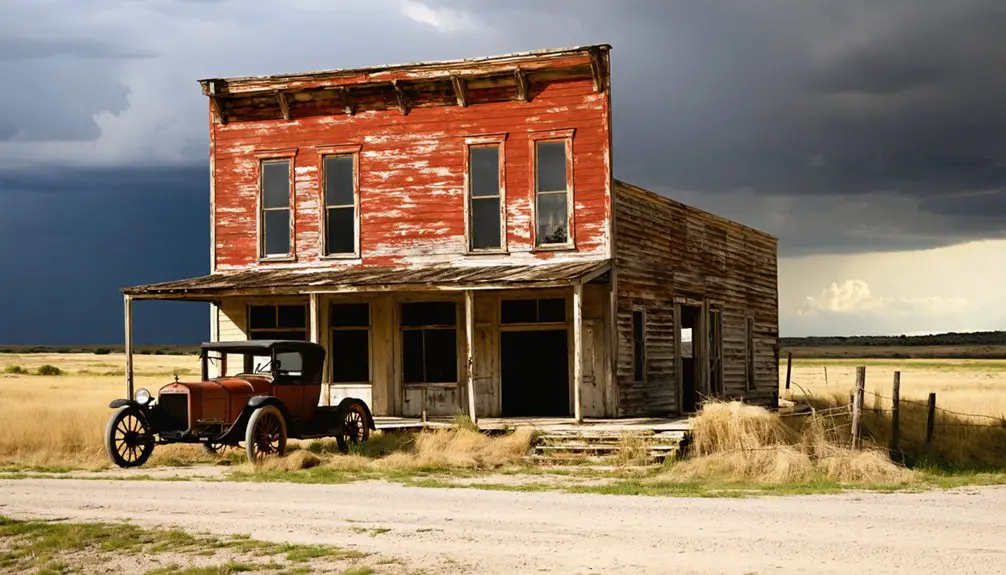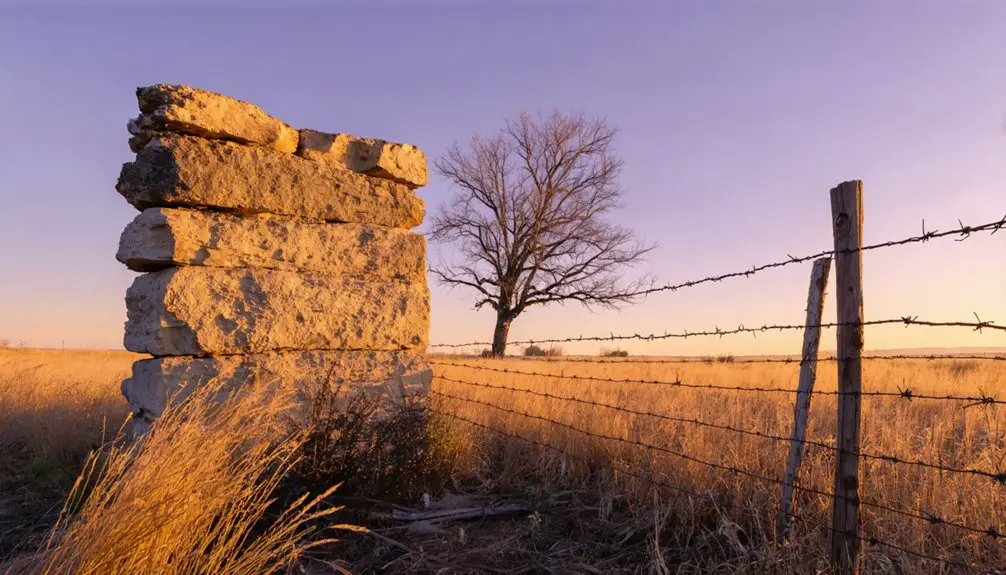You’ll find Lone Elm’s story began in the 1870s when Isaac K. Reeve purchased prairie land marked by a single elm tree. The town, initially named Reeve, flourished after the 1886 arrival of the St. Louis and Emporia railroad, reaching its peak population of 175 in 1910. As a crucial agricultural hub, it thrived until the Great Depression, railroad abandonment, and devastating fires led to its decline. The town’s transformation from bustling community to ghost town holds many surprising revelations.
Key Takeaways
- Lone Elm was established in 1873 and reached its peak population of 175 residents in 1910 before declining into a ghost town.
- The Great Depression, railroad abandonment in 1933, and the Dust Bowl caused significant population loss and economic devastation.
- Multiple devastating fires destroyed key businesses, while the closure of schools and post office eliminated essential community services.
- Originally named Reeve, the town flourished as a railroad shipping hub for livestock and grain before its eventual abandonment.
- The town’s decline accelerated when 90% of farming families relied on federal relief, prompting mass migration to California.
The Story Behind the Lone Elm Name
The tale of Lone Elm‘s name begins with a solitary elm tree that stood as a natural sentinel on the Kansas prairie in the 1870s. This distinctive landmark caught the attention of early settlers, particularly Isaac K. Reeve, who purchased hundreds of acres surrounding the tree for just $1.50 to $2.50 per acre in 1873.
The lone elm’s significance grew when Reeve established a post office near his home in 1879, naming it after the towering tree. The St. Louis and Emporia railroad’s arrival through the area in 1886 helped establish the town’s growing importance. Like many towns along the Oregon-California Trail, Lone Elm served as a vital stopover for westward migrants.
Though Reeve initially platted the town under his own name in 1886, the established identity of the post office led to an important change. To avoid confusion and honor the natural landmark that had guided so many travelers, the town’s name was officially changed from Reeve to Lone Elm.
Early Settlement and Railroad Years
In 1869, you’d find Isaac K. Reeve making his first visit to Anderson County, where he later purchased land from the railroad at $1.50 to $2.50 per acre in what would become Lone Elm.
By 1886, the St. Louis and Emporia Railroad‘s presence through Reeve’s property sparked his vision to plat a town, originally named Reeve, which he supported by constructing several buildings to attract businesses. Much like the Santa Fe Trail that had previously brought travelers through the region, the railroad became vital to the area’s commerce.
You can trace the town’s early growth to Reeve’s strategic planning and the railroad’s crucial role in connecting the settlement to larger markets, making it an attractive destination for settlers and merchants alike. The establishment of a post office in 1879 at Reeve’s cabin, where he served as postmaster, marked a significant milestone in the town’s development.
Railroad Shapes Town Growth
During the early 1900s, Missouri Pacific Railroad‘s strategic placement along Lone Elm’s south side transformed the small settlement into a thriving commercial hub. The railroad’s influence sparked an economic transformation that drew businesses, banks, and essential services to the town.
You’d have found a bustling stockyard north of the tracks, where local farmers shipped their livestock to distant markets.
While Lone Elm flourished, reaching a peak population of 175 in 1910, nearby Equity withered after being bypassed by the rail line. The town’s success hinged on Isaac K. Reeve’s vision – he invested in banks and constructed buildings to attract commerce.
Railroad access reshaped the entire region’s settlement patterns, determining which towns would prosper and which would fade into history.
Reeve’s Vision Takes Root
Seeking opportunities in Kansas Territory, Pennsylvania native Isaac K. Reeve made his way to Anderson County in 1873.
Driven by pioneering spirit, he carefully scouted southeastern Anderson County before purchasing hundreds of acres from the railroad at $1.50 to $2.50 per acre.
After securing his land, Reeve returned to Pennsylvania, married Hannah Louisa Winters, and brought his bride back to Kansas to fulfill his aspirations of building a new life. The couple established their homestead amid Anderson County’s undulating surface of rolling uplands and fertile bottom lands.
Rise as an Agricultural Hub
While many Kansas settlements struggled to establish themselves in the mid-1800s, Lone Elm emerged as a thriving agricultural center after Newton Ainsworth established the area’s first farm in 1857.
You’d have found Ainsworth’s 320-acre operation leading the way in agricultural innovations, particularly in livestock breeding, where he specialized in thoroughbred Short-horn cattle and Cotswold sheep.
The Missouri Pacific Railroad transformed Lone Elm into a bustling shipping hub, with stockyards north of the tracks handling daily livestock shipments. The area also served as a vital Santa Fe Trail marker, unveiled in 1906 to commemorate the region’s transportation heritage.
You could’ve witnessed freight trains moving east and west, carrying grain and hay to distant markets.
His success in breeding was proven when he earned first premiums at the Kansas City Exposition in 1873 and 1874.
The town’s agricultural backbone strengthened with essential services – hardware stores, implement dealers, veterinary care, and a lumberyard – all supporting the farming community’s needs until the railroad’s abandonment in 1933 marked the beginning of decline.
Community Life and Social Gatherings
While community life in Lone Elm centered around essential social gatherings, you’d find residents regularly participating in activities like horseshoe pitching, seasonal sledding, and movie screenings at the town hall.
You’d also witness how school plays and box suppers served as important fundraising events that strengthened community bonds in this small Kansas town.
Memorial Day gatherings proved especially significant, drawing more than 60 Civil War veterans to the local hall for commemorative events that united the townspeople.
Similar to other Kansas towns, residents would often gather at Haps restaurant to share meals and conversations with their neighbors.
Social Events and Recreation
As Lone Elm emerged in the late 1870s, its social fabric centered around several key gathering places established by founder Isaac K. Reeve. You’d find community bonding at the post office, railroad depot, and local businesses where residents exchanged news and shared daily life.
Recreational traditions included outdoor gatherings, seasonal picnics, and barn dances that brought families together. Throughout the agricultural seasons, you’d witness the town come alive with harvest celebrations and farming fairs. Despite being a small community, Lone Elm maintained more visible activity than many other tiny Kansas towns. To prevent confusion with other locations named Lone Elm, the town’s events were often labeled with geographical clarifications.
Churches hosted social meetings and holiday events, while school activities united parents and children. Baseball games and horseshoe pitching offered casual entertainment, while quilting bees and church suppers strengthened neighborly ties.
As the population peaked at 175, these gatherings fostered the close-knit atmosphere typical of rural Kansas towns.
Memorial Day Veteran Gatherings
Memorial Day gatherings in Lone Elm took on special significance through the local hall’s veteran commemorations, where over 60 Civil War veterans regularly assembled in the late 19th century.
These events fostered veteran camaraderie while strengthening bonds between military and civilian residents. You’d find the community joining together for box suppers, school plays, and literary society programs that enhanced the commemorative atmosphere.
The hall’s multipurpose nature supported both solemn remembrance and social connection, occasionally showing movies alongside memorial services.
Community remembrance centered on these gatherings, where activities like horseshoe pitching and sledding provided recreational outlets.
Through these integrated social events, Lone Elm’s residents maintained their commitment to honoring veterans while creating lasting traditions that bridged generations and preserved the town’s Civil War heritage.
Economic Peak and Business District

During its economic zenith in the late 19th and early 20th centuries, Lone Elm thrived as an essential shipping hub for livestock, grain, and hay, with two daily freight trains connecting the town to eastern and western markets.
The town’s business diversity reflected its economic resilience, featuring hardware stores run by Carrier and Schuessler, grocery outlets operated by Buck and Nester, and Stoll’s lumberyard.
Isaac K. Reeve’s strategic purchase of railroad land in 1886 established the foundation for this commercial growth, as he built structures specifically designed to attract merchants.
You’d find crucial services including Dr. Forsythe’s medical practice, Frank McVeigh’s veterinary clinic, and the Lone Elm Bank.
The daily passenger train service further strengthened the town’s commercial significance until the railroad’s abandonment in 1933.
Notable Events and Local Traditions
Life in Lone Elm centered around its vibrant community gatherings, where you’d find the local hall bustling with activity throughout the year.
Historical preservation efforts have documented the town’s rich traditions, including impressive Memorial Day services that drew over 60 Civil War veterans.
You’d experience the true spirit of this freedom-loving community through:
- School plays and box suppers that brought families together in the local hall
- Literary society programs that showcased local talent and creativity
- Evening movie screenings that transformed the hall into a makeshift theater
- Competitive horse shoe pitching matches that united neighbors in friendly rivalry
These community events defined Lone Elm’s character from its founding in 1873 through its peak years, creating lasting memories that survive even as the population has dwindled to just 27 residents by 2020.
The Great Depression’s Impact

As economic shockwaves from the 1929 stock market crash rippled across America, Lone Elm’s farming families faced devastating financial losses that would reshape their community forever.
The collapse of post-WWI commodity prices left farmers drowning in mortgage and machinery debt, while the Dust Bowl‘s arrival in 1933 delivered another crushing blow.
You’d have witnessed profound economic struggles as foreclosures and bankruptcies forced your neighbors to abandon their land.
Rural poverty became widespread, with up to 90% of families in the hardest-hit Kansas counties depending on federal relief programs.
The WPA and CCC offered some assistance through work projects and soil conservation efforts, but couldn’t stem the tide of outmigration.
Many Lone Elm residents joined the exodus west to California, permanently altering the town’s population and viability.
Factors Leading to Town’s Decline
While the Great Depression dealt Lone Elm its initial blow, multiple interconnected factors sealed the town’s fate between 1930-1956. The town’s population decline accelerated as agricultural mechanization transformed the farming landscape, requiring fewer workers to manage larger farms. This economic downturn triggered a chain reaction that undermined the community’s foundation.
Key factors that drove Lone Elm’s decline:
- Abandonment of the railroad in 1933, eliminating essential transportation links
- Devastating fires that destroyed necessary businesses, including the local bank
- Closure of schools, starting with the high school in 1946
- Loss of critical services like the post office, grocery stores, and churches
The combination of these factors created a downward spiral from which the town couldn’t recover, ultimately leading to its abandonment.
Present-Day Remnants and Legacy

Today’s visitors to Lone Elm encounter a quiet rural landscape where only scattered remnants hint at the town’s vibrant past.
You’ll find traces of the once-bustling commercial district, where hardware stores, furniture shops, and a lumberyard served the community. Though fires in the early 1900s destroyed many structures, remnants exploration reveals foundations of the historic railroad tracks and stockyard facilities that made Lone Elm an essential shipping center.
Crumbling foundations and old railway beds whisper stories of Lone Elm’s past glory as a vital frontier commerce hub.
While only 27 residents remained as of 2020, legacy preservation continues through local historical societies and online archives.
The town’s story lives on through archaeological evidence and cultural memory, offering insights into Kansas’s settlement era. The site serves as a reflection of rural transformation, where abandoned buildings and weathered foundations tell tales of railroad expansion and agricultural change.
Frequently Asked Questions
Are There Any Remaining Original Buildings Still Standing in Lone Elm Today?
You’ll find minimal historical preservation of original structures, with only the Methodist church-turned-community building and Presbyterian church-turned-barn maintaining any architectural significance in their repurposed forms today.
What Was the Highest Recorded Population in Lone Elm’s History?
You won’t find a clear peak population documented in historical records, but the town’s historical significance was modest, with recent counts around 27 people marking a population decline from its early railroad days.
Did Any Famous People or Events Originate From Lone Elm?
While there weren’t any nationally famous residents, Isaac K. Reeve and Dr. Manley Forsythe held local historical significance. The town’s biggest claim was hosting large Memorial Day gatherings with Civil War veterans.
What Happened to the Original Lone Elm Tree After the Town’s Naming?
Like a fading pioneer’s footprint, you won’t find records of the tree’s ultimate fate. Despite its historical symbolism as the town’s namesake, the lone elm’s destiny remains lost to time.
Were There Any Native American Settlements in the Lone Elm Area?
While Native tribes like the Osage traversed the broader region, you won’t find documented historic sites of permanent settlements directly at Lone Elm’s location – they preferred riverside villages in surrounding areas.
References
- https://legendsofkansas.com/lone-elm-kansas/
- https://simple.wikipedia.org/wiki/Lone_Elm
- https://octa-trails.org/archaeology/uniontown-and-plowboy-potawatomi-ghost-towns-enigmas-of-the-oregon-california-trail/
- https://www.youtube.com/watch?v=iB5rHT14eVI
- https://historyandersoncoks.org/lone-elm
- https://ksgenweb.org/archives/1912/l/lone_elm.html
- https://octa-trails.org/wp-content/uploads/2023/05/Lone-Elm-Campground-Historical-Marker.pdf
- https://jocohistory.wordpress.com/2023/07/15/johnson-county-kansas-a-brief-historical-sketch/
- https://en.wikisource.org/wiki/Kansas:_A_Cyclopedia_of_State_History/Anderson_County
- https://historyandersoncoks.org/railroads



